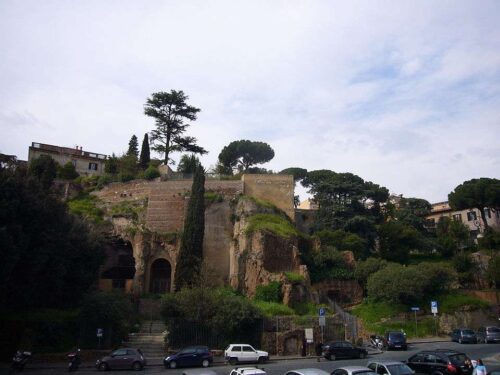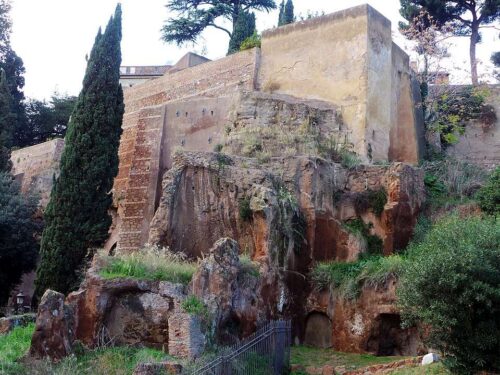Crime and punishment are a part of any society, with many ancient civilizations (and modern ones, for that matter) devising unique, and at times grotesque, ways of dealing with its criminals. For the Romans, one such grotesque method was the Tarpeian Rock.
Located on the southern side of the Capitoline Hill, the Tarpeian Rock (Rupes Tarpeia or Saxum Tarpeium) is a steep cliff that was used to hurl the worst of Rome’s criminals off. The cliff measures 80 feet (25 meters) in height.
According to the Romans, the Tarpeian Rock got its name from Tarpeia, the daughter of Spurius Tarpeius, who was the governor of the citadel atop the Capitoline Hill.
As the story goes, Rome was at war with the Sabines during the reign of Rome’s legendary founder, Romulus. The Sabines were attacking the Romans in revenge as the Romans took part in the Rape of the Sabine women – itself a monumental event in Roman history.
The Rape of the Sabine women occurred when Rome was still in its infancy and was trying to grow. With a lack of women in its settlement, Romulus tried negotiating with surrounding tribes to have their women marry the Roman men. When this was rejected, the Romans devised a plan to invite the neighboring tribes to a Roman festival.

The neighbors attended, including the Sabines. Late in the night, Romulus gave the signal. They detained the Sabine women and fought off the Sabine men. The women were then forced to marry Roman men and have families with them.
Back to the revenge attack of the Sabines…..
Tarpeia had engaged the Sabines outside the walls of the citadel. Titus Tatius (also known as Tatius Sabinus), the ruler of the Sabines, had convinced Tarpeia to betray the Romans by promising her jewels and gold. Having been let into the city, the Sabines quickly killed Tarpeia by crushing her with their shields. Livy, in his book, The History of Rome, recounts the event in detail in Book I, XI:
“The last of these wars was commenced by the Sabines and proved the most serious of all, for nothing was done in passion or impatience; they masked their designs till war had actually commenced. Strategy was aided by craft and deceit, as the following incident shows.
Spurius Tarpeius was in command of the Roman citadel. Whilst his daughter had gone outside the fortifications to fetch water for some religious ceremonies, Tatius bribed her to admit his troops within the citadel. Once admitted, they crushed her to death beneath their shields, either that the citadel might appear to have been taken by assault or that her example might be left as a warning that no faith should be kept with traitors. A further story runs that the Sabines were in the habit of wearing heavy gold armlets on their left arms and richly jeweled rings and that the girl made them promise to give her ‘what they had on their left arms,’ accordingly, they piled their shields upon her instead of golden gifts. Some say that in bargaining for what they had in their left hands, she expressly asked for their shields, and being suspected of wishing to betray them, fell a victim to her own bargain.”
Her body was said to be buried on the hill which now bears her name. Criminals guilty of such crimes as murder, treason, and sedition were given a shameful end, thrown off a cliff forever linked to betrayal, bringing added shame to the guilty party’s family.
There were many people hurled off the Rock, with bandits, consuls, rebels, wealthy men, and poets all suffering the ignominious fate.

By Lalupa – Own work, CC BY-SA 4.0
It is interesting, however, that Dionysius of Halicarnassus presents a totally different perspective on the events in his book, Roman Antiquities. He suggests that Tarpeia was planning to trick the Sabines into giving up their weapons so that the Romans could take them hostage. But it was Tarpeia who was betrayed by her messenger, who informed the Sabines of Tarpeia’s plan. Book II, XXXIX – XL notes:
“For Piso, the ex-censor, whom I mentioned before, says that a messenger was sent out of the place by Tarpeia in the night to inform Romulus of the agreement she had made with the Sabines, in consequence of which she proposed, by taking advantage of the ambiguity of the expression in that agreement, to demand their defensive arms, and asking him at the same time to send a reinforcement to the fortress that night, so that the enemy together with their commander, being deprived of their arms, might be taken prisoners; but the messenger, he says, deserted to the Sabine commander and acquainted him with the designs of Tarpeia. Nevertheless, Fabius and Cincius say that no such thing occurred, but they insist that girl kept her treacherous compact. In what follows, however, all are once more in agreement. For they say that upon the arrival of the king of the Sabines with the flower of his army, Tarpeia, keeping her promise, opened to the enemy the gate agreed upon and, rousing the garrison, urged them to save themselves speedily by other exits unknown to the enemy as if the Sabines were already masters of the place; that after the flight of the garrison the Sabines, finding the gates open, possessed themselves of the stronghold, now stripped of its guards, and that Tarpeia, alleging that she had kept her part of the agreement, insisted upon receiving the reward of her treachery according to the oaths.
Here again, Piso says that when the Sabines were ready to give the girl the gold they wore on their left arms, Tarpeia demanded of them their shields and not their ornaments. But Tatius resented the imposition and, at the same time, thought of an expedient by which he might not violate the agreement. Accordingly, he decided to give her the arms as the girl demanded but to contrive that she should make no use of them; and immediately poising his shield, he hurled it at her with all his might and ordered the rest to do the same; and thus Tarpeia, being pelted from all sides, fell under the number and force of the blows and died, overwhelmed by the shields. But Fabius attributes this fraud in the performance of the agreement to the Sabines; for they, being obliged by the agreement to give her the gold as she demanded, were angered at the magnitude of the reward and hurled their shield at her as if they had engaged themselves by their oaths to give her these.”
According to Dionysius, he is of the belief that Piso is correct in his account of how the events unfolded in Book II, XL:
“But what followed gives the greater appearance of truth to the statement of Piso. For she was honored with a monument in the place where she fell and lies buried on the most sacred hill of the city, and the Romans every year perform libations to her (I relate what Piso writes); whereas, if she had died in betraying her country to the enemy, it is not to be supposed that she would have received any of these honors, either from those whom she had betrayed or from those who had slain her, but, if there had been any remains of her body, they would in the course of time have been dug up and cast out of the city, in order to warn and deter others from committing the like crimes.”
Regardless of who was right and who was wrong, the only thing that has mattered is how the story has been portrayed throughout the centuries. The prevailing theory is that she betrayed the Romans and met a violent end.
We will never know how much of the events surrounding the death of Tarpeia are true. Many of these ancient stories and events were mythical but perhaps served a purpose in building the culture of that society. Or it was a story passed down through the generations as a lesson on what happens if you betray your country folk. It may have some basis in facts, but the details have been embellished and changed so much over time that it barely resembles what originally happened.

By Rabax63 – Own work, CC BY-SA 4.0
One of the earliest accounts we have of the Tarpeian Rock being used as a way of punishing criminals is when Dionysius of Halicarnassus discusses the death of Romulus in Book II, LVI. In it, he mentions that the patricians were unhappy at the unequal treatment of Romans as opposed to hostages from a neighboring tribe whom he released.
“But those who write the more plausible accounts say that he was killed by his own people; and the reason they allege for his murder is that he released without the common consent, contrary to custom, the hostages he had taken from the Veientes, and that he no longer comported himself in the same manner toward the original citizens and toward those who were enrolled later, but showed greater honor to the former and slighted the latter, and also because of his great cruelty in the punishment of delinquents (for instance, he had ordered a group of Romans who were accused of brigandage against the neighboring peoples to be hurled down the precipice after he had sat alone in judgment upon them.”
As the story of Romulus is one of Roman legend, we have a few other notable people who were hurled off the Tarpeian Rock. They include Spurius Cassius Viscellinus (after he was found guilty of treason) in 485 BC, Marcus Manlius Capitolinus (for sedition) in 384 BC, rebels from Tarentum in 212 BC, Lucius Cornelius Chrysogonus in 80 BC, Syllaeus in 6 BC, Aelius Saturninus in AD 23, Sextus Marius in AD 33 and Simon bar Giora in AD 70.
There does not appear to be a lot of information about people being thrown off the Tarpeian Rock after this point. Perhaps with the expansion of the city and the place becoming more crowded, it was no longer a viable method of killing criminals.
Or it could just be that it was not efficient, and it was just easier to kill them on the spot and do away with the body instead of turning the death sentence into a long procession.
Whatever the reasons, its prominent position in the heart of Rome served as a daily reminder to every Roman of the possible consequences of betraying their fellow Romans or the emperor himself. The threat of being thrown off the Rock must have kept many people in check. I am sure that threat was used many times throughout Roman history.
Souces:
Livy – The History of Rome (Perseus & Rev. Canon Roberts) – https://www.perseus.tufts.edu/hopper/text?doc=Perseus%3Atext%3A1999.02.0026%3Abook%3D1%3Achapter%3D11
Dionysius of Halicarnassus – Roman Antquities (Thayer) – https://penelope.uchicago.edu/Thayer/E/Roman/Texts/Dionysius_of_Halicarnassus/2B*.html

